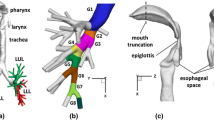Abstract
In order to evaluate the effect of anatomic asymmetries on the gas concentration distribution in the pulmonary airways, a Monte Carlo simulation of combined bulk flow and molecular diffusion was carried out in a realistic distal airway model (Parkeret al., 1971). This airway model, composed of branches distal to the 0.5-ram diameter airways, contained an upper symmetric segment consisting of four generations of conducting airways and a lower asymmetric segment of alveolar ducts and sacs arranged in five transport paths of varying lengths. In accounting for the volume increases of these ducts and sacs occurring during normal respiration, uniform alveolar filling rates and a fixed length-to-diameter ratio of all airways were assumed. For a pulse injection of inert tracer gas, the simulation was employed to determine the longitudinal concentration profiles in the conducting airways. In the alveolated airways, not only were the longitudinal profiles determined along each path, but radial transport from the core to the periphery of the airways was considered.
The results of the simulations indicate that geometric asymmetries alone contribute substantially to regional concentration variations in the distal airways. For example, when a gas bolus is injected at mid*inspiration, there are concentration differences as great as 40% between two points along different transport paths located equi-distant from the proximal end of the model. As viewed from the terminal end of the model (acinus), average concentration differences as large as 6-to-1 exist between the longest and shortest transport paths respectively for gas boli introduced near the end of inspiration. The results further indicate because of large radial diffusion rates, no significant concentration differences exist between the periphery a-ld the central core of alveolated airways.
Simulation of the expired concentration profiles indicate that boll injected very late during inspiration exhibit a sloping tail, unlike the earlier injected boll whose tails are virtually horizontal. Through the use of superposition teehniqnes, it was found that these sloping tails correspond to an alveolar slope of 1.5 vol% between 750 and 1250 ml expired for a continuous washing of tracer. This result is in disagreement with other transport analyses which did not directly account for the effect of geometric asymmetries.
Similar content being viewed by others
Literature
Baker, L. G., J. S. Ultman and R. A. Rhoades. 1974. “Simultaneous Gas Flow and Diffusion in a Symmetric Airway System: A Mathematical Model.”Resp. Physiol.,21, 119–138.
Bohr, C. 1891. “Ueber die Lungenathmung.”Skand. Arch. Physiol.,2, 236–268.
Carslaw, H. S. and J. C. Jaeger. 1959.Conduction of Heat in Solids, 2nd Ed. London: Oxford University Press, p. ll2ff.
Crank, J. 1956.Mathematics of Diffusion, 1st Ed. London: Oxford University Press, a) p. 27ff, b) p. 58ff.
Cumming, G., J. G. Jones and K. Horsfield. 1969. “Inhaled Argon Boluses in Man.”J. Appl. Physiol.,27, 447–451.
———, K. Horsfield and S. Preston. 1971. “Diffusion Equilibrium in the Lungs Examined by:Nodal Analysis.”Resp. Physiol.,12, 329–345.
Feller, V. J. 1968.Introduction to Probability Theory and Its Applications, Vol. 1, 3rd Ed. New York: John Wiley and Sons Inc.
Horsfield, K., G. Dart, D. E. Olson, C. F. Filley and G. Cumming. 1971. “Models of the Human Bronchial Tree.”J. Appl. Physiol.,31, 207–217.
Parker, H., K. Horsfield and G. Cumming. 1971. “Morphology of Distal Airways in the Human Lung.”J. Appl. Physiol.,31, 386–391.
Paiva, M. 1972. “Computation of the Boundary Conditions for Diffusion in the Human Lung.”Computer Biomed. Res.,5, 585–595.
———. 1973. “Gas Transport in the Human Lung.”J. Appl. Physiol.,35, 401–410.
———. 1974. “Gaseous Diffusion in an Alveolar Duct Simulated by Digital Computer.”Comp. Biomed. Res.,7, 533–543.
Scherer, P. W., L. H. Shendalman and N. M. Green. 1972. “Simultaneous Diffusion and Convection in Single-Breath Lung Washout.”Bull. Math. Biophys.,349 393–412.
Stibitz, G. R. 1969. “Calculating Diffusion in Biological Systems by Random Walks with Special Reference to Gaseous Diffusion in the Lungs.”Resp. Physiol.,7, 230–262.
Weibel, E. R. 1963.Morphometry of the Human Lung, New York: Academic Press, p. 136.
Author information
Authors and Affiliations
Rights and permissions
About this article
Cite this article
Mon, E., Ultman, J.S. Monte Carlo simulation of simultaneous gas flow and diffusion in an asymmetric distal pulmonary airway model. Bltn Mathcal Biology 38, 161–192 (1976). https://doi.org/10.1007/BF02471754
Received:
Revised:
Issue Date:
DOI: https://doi.org/10.1007/BF02471754




